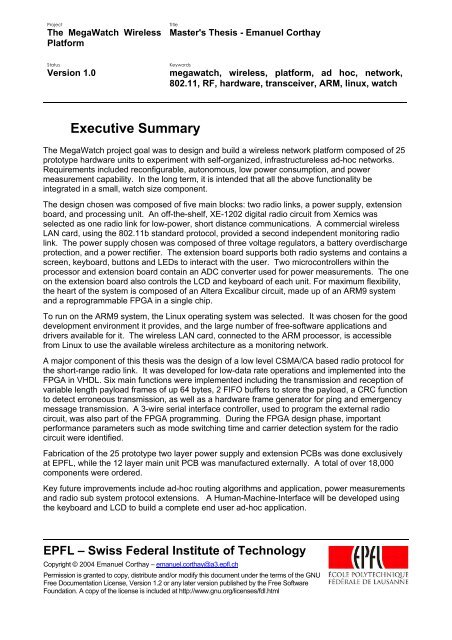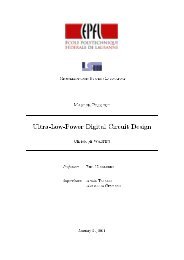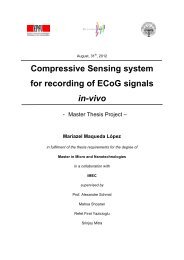Design and Realization of a Prototype Hardware Platform for ...
Design and Realization of a Prototype Hardware Platform for ...
Design and Realization of a Prototype Hardware Platform for ...
You also want an ePaper? Increase the reach of your titles
YUMPU automatically turns print PDFs into web optimized ePapers that Google loves.
ProjectThe MegaWatch Wireless<strong>Plat<strong>for</strong>m</strong>TitleMaster's Thesis - Emanuel CorthayStatusVersion 1.0Keywordsmegawatch, wireless, plat<strong>for</strong>m, ad hoc, network,802.11, RF, hardware, transceiver, ARM, linux, watchExecutive SummaryThe MegaWatch project goal was to design <strong>and</strong> build a wireless network plat<strong>for</strong>m composed <strong>of</strong> 25prototype hardware units to experiment with self-organized, infrastructureless ad-hoc networks.Requirements included reconfigurable, autonomous, low power consumption, <strong>and</strong> powermeasurement capability. In the long term, it is intended that all the above functionality beintegrated in a small, watch size component.The design chosen was composed <strong>of</strong> five main blocks: two radio links, a power supply, extensionboard, <strong>and</strong> processing unit. An <strong>of</strong>f-the-shelf, XE-1202 digital radio circuit from Xemics wasselected as one radio link <strong>for</strong> low-power, short distance communications. A commercial wirelessLAN card, using the 802.11b st<strong>and</strong>ard protocol, provided a second independent monitoring radiolink. The power supply chosen was composed <strong>of</strong> three voltage regulators, a battery overdischargeprotection, <strong>and</strong> a power rectifier. The extension board supports both radio systems <strong>and</strong> contains ascreen, keyboard, buttons <strong>and</strong> LEDs to interact with the user. Two microcontrollers within theprocessor <strong>and</strong> extension board contain an ADC converter used <strong>for</strong> power measurements. The oneon the extension board also controls the LCD <strong>and</strong> keyboard <strong>of</strong> each unit. For maximum flexibility,the heart <strong>of</strong> the system is composed <strong>of</strong> an Altera Excalibur circuit, made up <strong>of</strong> an ARM9 system<strong>and</strong> a reprogrammable FPGA in a single chip.To run on the ARM9 system, the Linux operating system was selected. It was chosen <strong>for</strong> the gooddevelopment environment it provides, <strong>and</strong> the large number <strong>of</strong> free-s<strong>of</strong>tware applications <strong>and</strong>drivers available <strong>for</strong> it. The wireless LAN card, connected to the ARM processor, is accessiblefrom Linux to use the available wireless architecture as a monitoring network.A major component <strong>of</strong> this thesis was the design <strong>of</strong> a low level CSMA/CA based radio protocol <strong>for</strong>the short-range radio link. It was developed <strong>for</strong> low-data rate operations <strong>and</strong> implemented into theFPGA in VHDL. Six main functions were implemented including the transmission <strong>and</strong> reception <strong>of</strong>variable length payload frames <strong>of</strong> up 64 bytes, 2 FIFO buffers to store the payload, a CRC functionto detect erroneous transmission, as well as a hardware frame generator <strong>for</strong> ping <strong>and</strong> emergencymessage transmission. A 3-wire serial interface controller, used to program the external radiocircuit, was also part <strong>of</strong> the FPGA programming. During the FPGA design phase, importantper<strong>for</strong>mance parameters such as mode switching time <strong>and</strong> carrier detection system <strong>for</strong> the radiocircuit were identified.Fabrication <strong>of</strong> the 25 prototype two layer power supply <strong>and</strong> extension PCBs was done exclusivelyat EPFL, while the 12 layer main unit PCB was manufactured externally. A total <strong>of</strong> over 18,000components were ordered.Key future improvements include ad-hoc routing algorithms <strong>and</strong> application, power measurements<strong>and</strong> radio sub system protocol extensions. A Human-Machine-Interface will be developed usingthe keyboard <strong>and</strong> LCD to build a complete end user ad-hoc application.EPFL – Swiss Federal Institute <strong>of</strong> TechnologyCopyright © 2004 Emanuel Corthay – emanuel.corthay@a3.epfl.chPermission is granted to copy, distribute <strong>and</strong>/or modify this document under the terms <strong>of</strong> the GNUFree Documentation License, Version 1.2 or any later version published by the Free S<strong>of</strong>twareFoundation. A copy <strong>of</strong> the license is included at http://www.gnu.org/licenses/fdl.html















